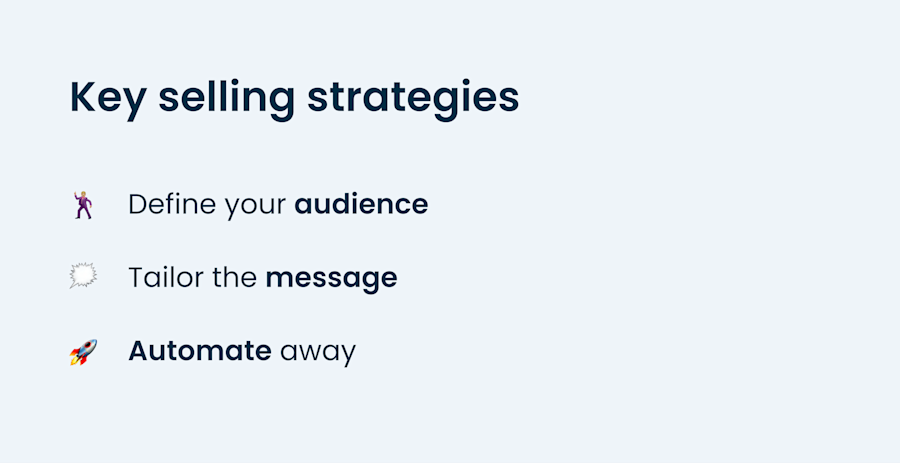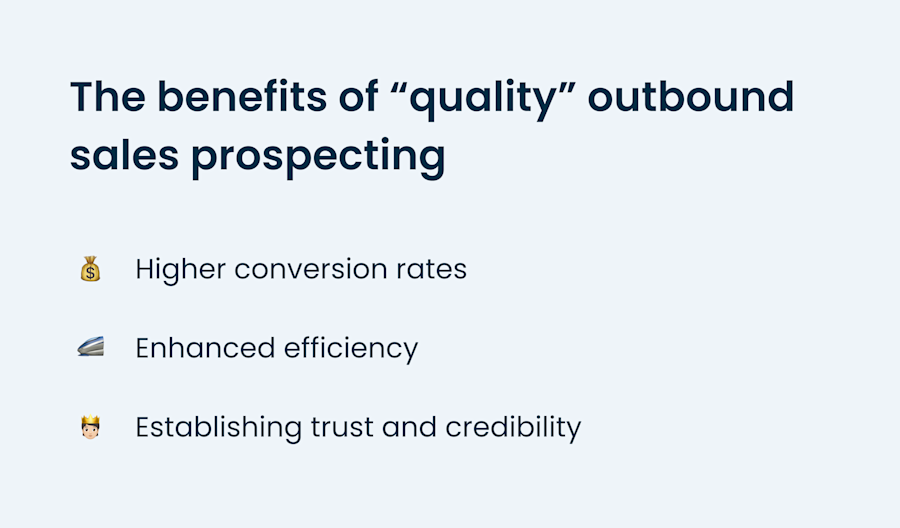Quantity or quality?
It's the age-old question every sales professional encounters when putting together their outbound sales strategy. Some gurus would have you believe the only way to close a sale is to put together a badass sales pitch.
Others advocate for the spray-and-pray approach. If you're not making 200 calls a day, can you even call yourself a sales professional?
In my years as an outbound salesman, I've spent countless hours searching for the perfect balance between quality and quantity. The solution: You have to focus on both aspects equally. You can't rely on a silver-bullet sales strategy.
Instead, you need to take a multifaceted approach. Incorporating a range of strategies and tactics into your repertoire may not be easy, but it'll pay off in spades over the long run.
Key selling strategies

The following tips and tricks will maximize your odds of creating a strong pipeline while balancing quantity and quality.
Define your audience
Over the years, I've discovered that one of the best ways to define my target audience is by using data and analytics. This involves analyzing customer demographics, behaviors, and preferences in order to identify the most promising leads.
You don't want to sell to just anyone. By targeting the right people, you can increase your chances of making meaningful connections and building long-term relationships.
Tailor the message
This next insight is basic, yet so fundamental for salespeople of all stripes. You need to personalize your message each and every time you make a sales pitch. No two humans are exactly alike, and no two customers share the exact same needs and concerns.
Do your due diligence and uncover your prospect's pain points. To an extent, the quality of a lead is what you make of it.
Automate away
It's 2023, and you have more computing power in your jean pocket than NASA had at its disposal when it landed the first men on the moon. Take advantage of automation tools with every chance you get. Streamline your outreach approach with automated workflows, scheduled email reminders, and anything else that tickles your fancy.
Ask around the office to see what your coworkers are using, and don't be afraid to experiment until you reach the optimal tool set.
What is the difference between prioritizing quality vs. quantity?
Lead generation can make or break a company's success. Most businesses care about high-quality leads (aka leads that will convert). Of course, some things are easier said than done. What the best lead generation strategy is remains an essentially open question.
Why? Well, for starters, different strategies have varying success rates depending on what's being sold. Spamming the internet with ads for a high-end luxury watch won't net you great results.
Niche products have niche audiences, and when you’re selling to a small and disbursed group of buyers, targeting matters ― a lot. Focusing on high-quality lead generation will net you that enterprise-level software sale.
By contrast, goods with mass appeal benefit from more exposure. The greater the quantity of people you can reach, the better (think Little Caesars Pizza). If you're selling a smartphone that retails for less than $100 or a productivity tool aimed at students, working professionals, retirees, and everyone in between, well, you're better off prioritizing quantity over quality.
Shades of gray
The examples used above are pretty black and white. But what about products that fall somewhere in the middle? And where do you draw the line between quantity and quality anyway? A single high-quality lead for your luxury watch just isn't going to cut it, nor are a million leads for your productivity app if your conversion rate is a rounding error.
One way to strike a balance between the two is to generate a high quantity of leads initially before winnowing them down until you're left with the highest-quality leads. It's also important to pay attention to your conversion rate.
Ask your colleagues what a good conversion rate looks like for your product or industry. You can also consult Google to get an idea of how many customers you should be converting.
If your conversion rate is low, you have too many low-quality leads. If it's high, you might benefit from bolstering your lead pool.
The benefits of “quality” outbound sales prospecting

When you choose quality over quantity, you’re focused on bringing in only high-quality leads. We're talking about leads that meet your ideal customer persona, or at least your target audience.
A more targeted approach to outbound sales prospecting can net you a number of significant benefits, including the following.
Higher conversion rates
By focusing on quality leads, you can increase your conversion rate. Think of it as front-loading versus back-loading your work. High-quality leads, by definition, are a closer fit to your ideal customer persona or target audience. That means your high-quality leads are much more likely to have the unique pain points your product or service can fix.
Enhanced efficiency
Quality outbound prospecting can also help improve the overall efficiency of the sales process. By focusing on fewer higher-quality leads, you can spend more time engaging with each prospect.
As you spend time learning about their specific needs and preferences, you can tailor your sales pitch to hit a customer's unique pain points. This can lead to more productive conversations and, ultimately, a shorter sales cycle.
Establishing trust and credibility
Quality outbound prospecting can also help you establish your brand as a trusted authority in your industry. By taking a more targeted approach to prospecting, you can position yourself as a knowledgeable and helpful resource.
Don't be just another pushy salesperson. Distinguish yourself by becoming a subject-matter expert. Trust and credibility are key ingredients for turning prospects into repeat customers.
The pitfalls of mainly focusing on quality

Before you go all in on a "quality" approach to sales prospecting, it's important to educate yourself about the potential shortcomings. Here are three of the biggest pitfalls that sales professionals typically encounter when focusing on quality outbound prospecting.
Narrow focus
One common pitfall of focusing on quality outbound prospecting is that it can be easy to narrow your focus too much and miss out on potential leads. While it's important to target high-quality leads, you should also maintain a broad enough perspective to capture potential customers who may not fit perfectly into your ideal customer persona.
Wasted time
Spending too much time on each lead is another common pitfall. Allocating excessive amounts of time per prospective customer can contribute to a longer sales cycle, lowering your overall efficiency. Strike a balance between tailoring your approach to each prospect and maintaining a reasonable pace. Don't get so caught up on a single prospect that you let your pipeline go dead.
Missed opportunities
You can't grow if your sole focus is on your existing pipeline. Yes, it's important to maximize the quality of your sales leads, but that's no excuse to turn a blind eye to market trends and customers who might not fit your ideal profile. As always, the key here is balance.
The benefits of “quantity” outbound sales prospecting

When it comes to lead generation, some companies try to capture as many leads as possible by widening their sales funnel. The math here is simple: Yes, your conversion rate will be lower, but presumably, you'll make up for it in volume. For example, a conversion rate of 4 percent on 100 leads nets you 4 sales. Not bad. A conversion rate of 1 percent on 1,000 leads gets you 10 sales.
Quantity wins out here two-and-a-half times over despite having half the conversion rate. Of course, this hypothetical scenario assumes everything else is held equal, aside from the number of leads and the conversion rate. Any seasoned sales professional will tell you that with so many variables at stake, the quantity vs. quality debate is more an art than a science.
As a sales professional, I've had the opportunity to experiment with different approaches to outbound prospecting, including both quality- and quantity-based strategies. Here are the top three advantages of pursuing a quantity-based sales strategy.
Increased lead volume
Quantity-based prospecting lets you reach a larger number of potential customers. That makes it easy to fill your sales pipeline with a high volume of leads. In turn, you can keep your sales funnel moving. If you feel like you're falling behind your peers because you're not reaching enough prospects, it might be time to try out a quantity-based lead gen strategy.
Better efficiency
Every doctor has to go through residency. In what’s essentially a professional hazing program, resident doctors routinely work in excess of 100-hour weeks. Is it brutal? Yes. But the results speak for themselves. There's a reason why society holds up doctors and surgeons as consummate professionals.
Now, I'm not saying you have to stick around past 5 p.m. But getting in that extra practice wherever it presents itself can help you identify common objections and challenges, hone your messaging and pitch, and develop strategies for overcoming these obstacles. The more people you talk to, the more you'll improve as a sales professional.
Opening up new markets
One of the best ways to identify new opportunities and potential markets is by talking to people. Get out there and put your finger on the market's pulse. Opening up your prospect list for greater diversity can help you gain valuable insights into emerging trends and needs. You can then turn around and use this information to refine your approach and stay ahead of the competition.
The pitfalls of mainly focusing on quantity

It's possible to have too much of a good thing. That holds equally true for ice cream and quantity-based lead generation. Here are three of the biggest issues that you need to look out for when you favor quantity over quality.
Burnout
We're only human. As salespeople, it's important to take a big step back on occasion and realistically assess how much work we can actually do before we fall prey to burnout. The reality is that anyone can call 100-plus leads a day for a month or two. But how many people do you see pulling those numbers even a year or two into their career?
The sales industry has a notoriously high turnover rate. While a number of factors are driving this phenomenon, it's safe to say that burnout features prominently among them. The sales world is hard enough as it is. Burning yourself out by churning through hundreds of low-quality leads only results in decreased motivation and ineffective outreach efforts.
Impersonal sales pitches
Time is a scarce resource. The more of it you allocate to broadening your audience, the less you can devote to deepening your outreach efforts. This can result in generic or ineffective messaging that doesn't resonate with potential customers.
Lower conversion rates
Rapidly expanding your total number of leads inevitably has a negative impact on your conversion rate. You can't help it. Now, a lower conversion rate isn't necessarily a bad thing if it leads to an overall gain in customers without requiring too much extra effort, but there's no getting around the fact that lower conversion rates directly lead to wasted time and resources.
Which outbound sales prospecting strategy is better?
Identifying your target market and ideal customer profiles is an important step in understanding where to focus your efforts.
Based on my experience transitioning from transactional sales to strategic sales, I've found that incorporating aspects of both approaches can provide the best of both worlds. I've been able to build stronger connections with customers and drive long-term growth by leveraging the efficiency and speed of transactional sales while also adopting a more personalized and relationship-driven approach.
Pipeline Over Everything
As sales icon and thought leader Kevin "KD" Dorsey always says, the mantra is POE: Pipeline Over Everything.
Jeb Blount expands on that point in his book, Fanatical Prospecting, when he explains just how crucial prospecting is for sales professionals to achieve success. It doesn't matter whether you prioritize quality or quantity. If you choose to pursue a high-quality lead approach, it's still important to continuously search for and engage with potential customers to fill your pipeline and keep your sales funnel moving.
Similarly, a quantity-based approach may involve casting a wider net and engaging with a larger number of leads. However, it's still essential to focus on identifying the most promising prospects and prioritize your efforts accordingly. By maintaining a consistent prospecting cadence and adapting your approach as needed based on your target audience and market trends, you can stay ahead of the competition and maximize your chances of success.
Now that you're here
Leadfeeder is a tool that shows you companies that visit your website. Leadfeeder generates new leads, offers insight on your customers and can help you increase your marketing ROI.
If you liked this blog post, you'll probably love Leadfeeder, too.
Sign up




